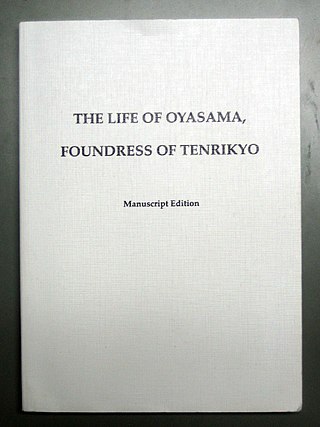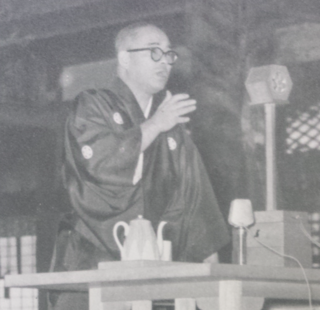
Tenrikyo is a Japanese new religion which is neither strictly monotheistic nor pantheistic, originating from the teachings of a 19th-century woman named Nakayama Miki, known to her followers as "Oyasama". Followers of Tenrikyo believe that God of Origin, God in Truth, known by several names including "Tsukihi," "Tenri-Ō-no-Mikoto" and "Oyagamisama " revealed divine intent through Miki Nakayama as the Shrine of God and to a lesser extent the roles of the Honseki Izo Iburi and other leaders. Tenrikyo's worldly aim is to teach and promote the Joyous Life, which is cultivated through acts of charity and mindfulness called hinokishin.
The Ofudesaki is the most important scripture in Tenrikyo. It is one of Tenrikyo's three scriptures, along with the Mikagura-uta and the Osashizu. A 17-volume collection of 1,711 waka poems, the Ofudesaki was composed by the foundress of Tenrikyo, Miki Nakayama, from 1869 to 1882.

Nakayama Miki was a nineteenth-century Japanese farmer and religious leader. She is the primary figure of the Japanese new religion Tenrikyo. Followers, who refer to her as Oyasama (おやさま), believe that she was settled as the Shrine of Tsukihi from the moment she experienced a divine revelation in 1838 until her death in 1887.
The oyasato-yakata (おやさとやかた) complex is a collection of buildings in Tenri City, Nara, Japan, that form an incomplete square 872 m (954 yd) on each side surrounding the Divine Residence (Oyasato), a structure sacred to the Japanese new religion Tenrikyo. The task of revitalizing the area around the Residence was informed by both religious prophecy and city planning, and construction began in 1954 on a project that continues today. The oyasato-yakata is a massive organizational undertaking that is understood by Tenrikyo adherents as a spiritual practice, creating a model city that reflects their belief in a Joyous Life. As such a practice it has involved the entire Tenrikyo community, from the volunteers who assist in construction to professors who plan the scope of future wings. Archaeologists have also excavated ancient artifacts beneath its foundations.

In the Tenrikyo religion, the Osashizu is a written record of oral revelations given by Izo Iburi. It is one of the three scriptures of Tenrikyo, along with the Ofudesaki and the Mikagura-uta. The full scripture is published in seven volumes and contains around 20,000 "divine directions" delivered between January 4, 1887 and June 9, 1907.
Iburi Izō was the second spiritual leader, Honseki, of Tenrikyo after the death of Nakayama Miki (Oyasama) in 1887, while Oyasama's son Shinnosuke became the administrative leader, the Shinbashira. Having received the "grant of speech" from Oyasama, Iburi dictated the Osashizu, additional divinely inspired instructions on the creation and maintenance of a Tenrikyo community.
The Mikagura-uta is one of the three Tenrikyo scriptures, along with the Ofudesaki and the Osashizu. It was composed by the foundress of Tenrikyo, Miki Nakayama, from 1866 to 1875, and revised to its current version in 1882.

Tenrikyo Church Headquarters is the main headquarters of the Tenrikyo religion, located in Tenri, Nara, Japan. This establishment is significant to followers because it is built around the Jiba, the spot where followers believe the god Tenri-O-no-Mikoto conceived humankind.
In the Tenrikyo religion, the Service is the most important prayer ritual, along with the Sazuke. The Service comes in fundamental forms and several variant forms. The text to the Service is the Mikagura-uta, one of the three scriptures of Tenrikyo.
The History of Tenrikyo concerns the social and institutional development of Tenrikyo, from the day the teachings were founded by Miki Nakayama on October 26, 1838, to the present day.
The following is a timeline of the Tenrikyo religion, highlighting significant events since the birth of Tenrikyo's foundress Miki Nakayama. Specific dates are provided in parentheses; the lunar calendar is indicated with ordinal numbers while the Gregorian calendar is indicated with name and number.

The Sazuke refers to a prayer in which a Tenrikyo follower asks for divine intervention to heal an ailment.

The Life of Oyasama, Foundress of Tenrikyo, or The Life of Oyasama, is the biography of Nakayama Miki published and authorized by Tenrikyo Church Headquarters. The Life of Oyasama is one of the supplemental texts to the Tenrikyo scriptures, along with The Doctrine of Tenrikyo and Anecdotes of Oyasama.

The Doctrine of Tenrikyo is the doctrine of the Tenrikyo religion, published and sanctioned by Tenrikyo Church Headquarters. The Doctrine of Tenrikyo is one of the supplemental texts of the Tenrikyo scriptures, along with The Life of Oyasama and Anecdotes of Oyasama.
Tenrikyo theology is the theology of the Tenrikyo religion. The discipline of Tenrikyo theology consists of scriptural studies, historical theology, dogmatic theology, and practical theology.

Tenrikyo Doyusha is the official publisher of Tenrikyo Church Headquarters, disseminating news, information, and doctrinal materials related to Tenrikyo.

Nakayama Shōzen was the second Shinbashira of Tenrikyo. He was the first son of Nakayama Shinnosuke, the first Shinbashira, and the great-grandson of Nakayama Miki, the foundress of Tenrikyo.
Nakayama Shinnosuke was the first Shinbashira of Tenrikyo. He was the grandson of Nakayama Miki, the foundress of Tenrikyo.
Tenri Seminary is the seminary of the Japanese new religion Tenrikyo, located in Tenri, Japan.
The Tenrikyo creation narrative is the creation myth of the Tenrikyo religion. The narrative was conveyed by the foundress Nakayama Miki in writing through the Ofudesaki and orally to her early followers. After compiling the scriptures and the manuscripts left by early followers, Tenrikyo Church Headquarters formalized and published the narrative in chapter three of The Doctrine of Tenrikyo, titled "Truth of Origin".








